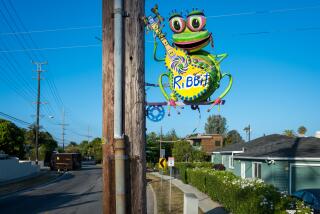Ball in Court of Panel as Tennis Buffs, Foes Volley
- Share via
Here’s a riddle that has puzzled Los Angeles officials for two years:
What is “invisible,” but won’t disappear? Started over a court, but ended up in a court? Is a bright idea to some but a dark threat to others?
The answer:
Controversial tennis-court lights behind luxury homes on a Sherman Oaks hilltop.
The question is whether city officials should allow the lights to be switched on and used at night.
The developer of the multimillion-dollar dwellings says nighttime tennis should be authorized because the lights are “invisible” and do not bother neighbors.
But the Sherman Oaks Homeowners Assn. and a group called Mulholland Tomorrow are demanding that the lights be banned. They argue that the reflected glow is a nuisance, even though the light bulbs themselves are shielded and cannot be seen.
Decisions Due Today
Officials are expected to decide the issue today at a planning commission hearing at the state office building in Van Nuys.
Both sides agree that the city’s decision will probably have an effect far beyond the 14900 block of Mulholland Drive, where the lights have been installed.
Lighting industry officials and tennis buffs elsewhere in Southern California are watching the case with interest because of light restrictions on tennis courts that other municipalities have imposed in recent years.
In Hidden Hills, a homeowner who has installed his own “invisible” lights will ask the City Council tonight to postpone legal action against him until a public vote on the lighting issue can be scheduled.
The Sherman Oaks lighting dispute has been growing since 1981, when the city planning commission approved an eight-house luxury development for the hilltop Mulholland Drive site.
As a condition of approval, the planning commission yielded to neighbors’ requests and specifically outlawed lighting for backyard tennis courts proposed as part of the project.
An Honest Mistake
Word of the lighting ban did not filter down to the city’s Department of Building and Safety, however. When developer Sheldon Appel applied later for permits for his first two courts, a department clerk mistakenly issued permits for lights as well. The poles were up and the newly designed lights hooked up before the neighbors noticed and complained.
The mix-up prompted an investigation by city officials. That, in turn, led to a lawsuit by homeowners.
The city’s Board of Referred Powers, a City Council panel, decided that an honest mistake had been made by the Department of Building and Safety worker. The board voted 3 to 2 to revise the tract’s conditions and to authorize use of the two lighted courts for one year.
The about-face angered the homeowners. The Sherman Oaks association and Mulholland Tomorrow successfully sued earlier this year in Los Angeles Superior Court to overturn the board action.
Appel and his partners in the project, meantime, filed an appeal with the planning commission in hopes of eliminating the lighting ban once and for all.
“They told us they really don’t object to the lights if they can’t see them,” Appel said. “We went out and got the latest technology. The lights we installed are totally invisible. To me, that’s a change in circumstance from the time the tract was approved.”
Illumination Elimination
The “invisible” lights were designed by lighting consultant Herb Bieber. He said they are specially shielded to prevent any illumination from spilling off the court.
“I’ve gone up there to look at them at night,” Bieber said. “I walked around and went up to the neighbor’s house. There was not one bit of glare. The porch lights at the back of the house were glarier.”
But Mulholland Tomorrow attorney Barbara S. Blinderman said glare from the tennis lights would damage the nighttime ambiance along Mulholland Drive, which she described as a “major scenic corridor and asset” of Los Angeles.
Richard Close, Sherman Oaks Homeowners Assn. president, said he inspected the lights one night two weeks ago and found the glare distracting.
“Actually, the lights are invisible,” Close said. “They’ve hidden the bulbs. But, since light reflects off surfaces, it illuminates the 6,000-square-foot house next to the court like the White House.
“They want lights on many courts up there. The glare would totally obstruct the view from Mulholland Drive. The effect for people down below would be to look up and see a sun at 11 p.m.”
Close said the Sherman Oaks lights are being viewed as a “breakthrough” that could lead to many new tennis-court light requests.
Bieber agreed. He said he already has installed similar shielded lights at other homes, including the residence of a Hidden Hills orthopedic surgeon, hoping for a citywide referendum on nighttime tennis play in his tiny gate-guarded city at the western edge of the San Fernando Valley.
Dr. Bernard Diamond said he will attend tonight’s Hidden Hills City Council meeting to discuss his tennis court and his plans for a public vote on the lighting issue. “With lenses and shielding, lights are not intrusive,” Diamond said Wednesday.
Hidden Hills has banned nighttime tennis lights since 1978. But Mayor Kathy Bartizal said some homeowners have put them up anyway. Others have sought to get around the restrictions by saying their courts are for such things as volleyball, she said.
“Some people have put lights on horse corrals that shine over on tennis courts,” Bartizal said. “There are lots of lighted corrals here.”
Celebrities have occasionally fought tennis-court light restrictions in Hidden Hills and in the Valley.
Entertainer John Davidson unsuccessfully fought the Hidden Hills ban in 1980 in Calabasas Municipal Court.
Tennis star Vijay Amritraj overcame neighbors’ objections and won permission in 1986 to build a tennis court at his new home in Encino after promising a Los Angeles city zoning administrator that it would not be lighted.
More to Read
Sign up for Essential California
The most important California stories and recommendations in your inbox every morning.
You may occasionally receive promotional content from the Los Angeles Times.














